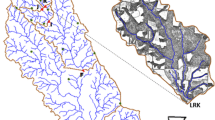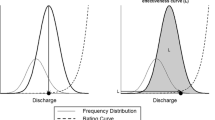Abstract
Information on tradeoffs among water quantity and quality attributes at a watershed scale is important in developing effective watershed conservation policies. Assessment of these multiattribute tradeoffs, a focus of this study, is often a low priority in policy design. A combination of simulation modeling and statistical assessment was used to evaluate the significance of relationships among runoff, sediment, nitrate, and phosphorus loading in 115 subwatersheds of the Blackstone River Watershed in southern New England. We observed high variability in rates of runoff, nitrate, phosphorus, and sediment loading among subwatersheds. Results of the regression analysis indicate a high correlation between nitrate and surface runoff, emphasizing the importance of stormwater management in mitigating nutrient loads. A significant relationship exists between mineral phosphorus and sediment yield in watersheds that could inform strategies to mitigate eutrophication problems in phosphorus-limited systems such as some inland water bodies. The tradeoff analysis proposed can be used in policy design and to assess the implications of various policies to address multiple pollutants.










Similar content being viewed by others
References
Andraski, T. W., & Bundy, G. L. (2002). Relationships between phosphorus levels in soil and in runoff from corn production systems. Journal of Environmental Quality, 32, 310–316.
Arnold, J. G., Williams, J. R., Srinivasan, R., King, K. W., & Griggs, R. H. (1994). SWAT, soil and water assessment tool. Temple, TX: USDA, Agriculture Research Service.
Arnold, J. G., Williams, J. R., & Maidment, D. (1995). Continuous-time water and sediment routing model for large basins. Journal of Hydrologic Engineering, 121, 171–183.
Barlow L. K. (1999). Estimated water use and availability in the lower Blackstone river basin, Northern Rhode Island and South-Central Massachusetts. Water-Resources Investigations Report, 03-4190.
Boutiette Jr., L. N., & Duerring, C. L. (1994). Massachusetts nonpoint source management manual. “The MegaManual” a guidance document for municipal officials. Boston, MA: Mass. Dept. Environmental Protection.
Calhoun, F. G., Bakerb, D. B., & Slaterc, B. K. (2002). Soils, water quality, and watershed size interactions in the Maumee and Sandusky river basins of Northwestern Ohio. Journal of Environmental Quality, 31, 47–53.
Campbell, D. E., Hill, B., Detenbeck, N. E., Engle, V. D., Ho, K., Kurtz, J. et al. (2003). Conceptual Models and Methods for Diagnosing the Causes of Impairment to Aquatic Ecosystems (EPA Report): National Health and Environmental Effects Research Laboratory, Gulf Ecology Division, Mid-Continent Ecology Division and Atlantic Ecology Division.
Copeland, C. (2005). Clean Water Act and Total Maximum Daily Loads (TMDLs) of pollutants. CRS Report to Congress, Congressional Research Service, The Library of Congress, pp. 97–831 ENR.
Das, P., & Haimes, Y. Y. (1979). Multiobjective optimization in water quality and land management. Water Resources Research, 15(6), 1313–1322. doi:10.1029/WR015i006p01313.
Dendy, F. E., & Bolton, G. C. (1976). Sediment yield-runoff-drainage area relationships in the United States. Journal of Soil and Water Conservation, 31(6), 264–266.
DiLuzio, M. R., Srinivasan, & Arnold, J. G. (1997). An integrated user interface for SWAT using ArcView and Avenue. ASAE Meeting, Minneapolis, MN, Aug. 10–14, Paper No. 972235.
Dunning, D. J., Ross, Q. E., & Merkhofer, M. W. (2000). Multiattribute utility analysis for addressing Section 316(b) of the clean water act. Environmental Science & Policy, 3(1), 7–14.
Ensign, S. H., McMillan, S. K., Thompson, S. P., & Piehler, M. F. (2005). Nitrogen and phosphorus attenuation within the stream network of a coastal, agricultural watershed. Journal of Environmental Quality, 35, 1237–1247.
EOEA. (2003). Blackstone River Watershed. Boston, MA: Executive Office of Environmental Affairs (EOEA).
ESRI. (2003). GIS and Mapping Software. ESRI Publishers. ISBN 0-9679208-2-5.
Glantz, S. A., & Slinker, B. K. (1990). Primer of applied regression and analysis of variance. New York, USA: McGraw-Hill.
Havens, K. E., & Schelske, C. L. (2001). The importance of considering biological processes when setting total maximum daily loads (TMDL) for phosphorus in shallow lakes and reservoirs. Environmental Pollution, 113(1), 1–9.
Hayakawa, A., Shimizu, M., Woli, K., Kuramochi, K., & Hatano, R. (2006). Evaluating stream water quality through land use analysis in two grassland catchments: Impact of wetlands on stream nitrogen concentration. Journal of Environmental Quality, 35, 617–627.
Lovejoy, S. B., Lee, J. G., Randhir, T. O., & Engel, B. A. (1997). Research needs for water quality management in the 21st century: A spatial decision support system. Journal of Soil and Water Conservation, 52(1), 18–22.
Lu, Y.-C., & Teasdale, J. (2003). An economic and environmental tradeoff analysis of sustainable agricultural cropping systems. Journal of Sustainable Agriculture, 22, 25–41. doi:10.1300/J064v22n03_05.
Male, J. W., & Ogawa, H. (1984). Tradeoffs in water quality management. Journal of Water Resources Planning and Management, 110(4), 434–444.
Mangarillo, J. T., Rees, P. S., Westphal, K., & Walsh, T. (2005). Basin-scale methodology for evaluating relative impacts of pollution source abatement. ASCE Conference—Watershed Management 2005, July 19–22, Williamsburg, Virginia.
Massachusetts Department of Environmental Protection (MA DEP). (1998). Massachusetts nonpoint source management manual. Boston, MA.
Massachusetts Department of Environmental Protection (MA DEP). (2001). Blackstone River Basin 1998 water quality assessment report. Worcester, Massachusetts: Massachusetts Department of Environmental Protection, Division of Watershed Management. Retrieved from http://www.mass.gov/dep/brp/wm/wqassess.htm.
Massachusetts Department of Environmental Protection (MA DEP). (2005). Division of Watershed Management Draft Pathogen TMDL for the Blackstone River Watershed. Boston, MA.
MassGIS. (1999). Data viewer utilities extension documentation. Boston, MA: MassGIS, EOEA.
McClave, J. T., & Benson, P. G. (1988). Statistics for business and economics. London: MacMillan.
Miller, J. J., Handerek, B. P., Beasley, B. W., Olson, E. C. S., Yanke, L. J., Larney, F. J., et al. (2003). Quantity and quality of runoff from a beef cattle feedlot in Southern Alberta. Published in Journal of Environmental Quality, 33, 1088–1097.
Neitsch, S. L., Arnold, J. G., Kiniry, J. R., Srinivasan, R., & Williams, J. R. (2002). Soil and water assessment tool: User manual, Version 2000. TWRI Rep. TR-192, College Station, TX: Texas Water Resources Institute (455 pp.).
Page, H. M., Petty, R. L., & Meade, D. E. (1995). Influence of watershed runoff on nutrient dynamics in a Southern California Salt Marsh. Estuarine, Coastal and Shelf Science, 41(2), 163–180.
Puckett, L., & Hughes, W. B. (2005). Transport and fate of nitrate and pesticides. Journal of Environmental Quality, 34, 2278–2292.
Randall, G., & Mulla, D. J. (2000). Nitrate nitrogen in surface waters as influenced by climatic conditions and agricultural practices. Journal of Environmental Quality, 30, 337–344.
Randhir, T. (2003). Watershed-scale effects of urbanization on sediment export: Assessment and policy. Water Resources Research, 39(6), 1169. doi:10.1029/2002WR001913.
Randhir, T. O., & Genge, C. (2005). Watershed based, institutional approaches to developing clean water resources. Journal of the American Water Resources Association, 41, 413–424.
Randhir, T. O., & Lee, J. G. (1997). Economic and water quality impacts of reducing nitrogen and pesticide use in agriculture. Agricultural and Resource Economics Review, 26, 39–51.
Randhir, T. O., Lee, J. G., & Engel, B. (2000). Multiple criteria dynamic spatial optimization to manage water quality on a watershed scale. Transactions of the American Society of Agricultural Engineers, 43(2), 291–299.
Santhi, C., Muttiah, R. S., Arnold, J. G., & Srinivasan, R. (2005). A GIS-based regional planning tool for irrigation demand assessment and savings using SWAT. American Society of Agricultural Engineers, 48(1), 137−147 (ISSN 0001−2351).
Sharpley, A. N. (1980). The enrichment of soil phosphorus in runoff sediment. Journal of Environmental Quality, 9, 521–526.
Srinivasan, R. S., Arnold, J. G., & Jones, C. A. (1998). Hydrologic modeling of the United States with the soil and water assessment tool. Water Resources Development, 14(3), 315–325.
US Census. (1999). Population estimates for cities with populations of 100,000 and greater (sorted by 1999 population size rank in U.S.): July 1, 1999 (includes April 1, 1990 population estimates base) (SU-99-1). Retrieved 25 Dec. 2007 from http://www.census.gov/popest/archives/1990s/SU-99-01.txt.
USDA -United States Department of Agriculture, Soil Conservation Service. (1986). Urban hydrology for small watersheds. Technical Release No. 55, 2nd edn. Washington, DC.
USEPA. (1996). Watershed approach framework. Office of Water, Washington, DC. EPA-840S96001.
USEPA. (2000). Ecological principles for managing land use. The Ecological Society of America. Committee on Land Use, April. http://www.epa.gov/watertrain/pdf/landuseb.pdf.
USEPA. (2001). Better assessment science integrating point and nonpoint sources—BASINS, version 3.0. User’s manual. Office of Water. EPA–823-B-01-001.
USEPA. (2004). Performance monitoring of MNA remedies for VOCs in ground water. EPA/600/R-04/027, April 2004.
USEPA. (2008). What is a TMDL? Overview of impaired waters and Total Maximum Daily Loads Program. US Environmental Protection Agency, Washington, DC. Retrieved 15 Oct, 2008 from http://www.epa.gov/owow/tmdl/overviewoftmdl.html#howtmdl.
Whiting, P. J. (2006). Estimating TMDL background suspended sediment loading to great lakes tributaries from existing data. Journal of the American Water Resources Association, 42(3), 769–776.
Williams, J. R., & Berndt, H. D. (1977). Sediment yield prediction based on watershed hydrology. Transactions of the ASAE, 20, 1100–1104.
Wolfe, M. L., Benham, B., Dukes, E. F., Morris, S., Collins, A., Borisova, T., et al. (2007). TMDL implementation plan development for a rapidly urbanizing watershed in Northern Virginia. In Watershed Management to Meet Water Quality Standards and TMDLS (Total Maximum Daily Load). Proceedings of the 10–14 March 2007 Conference, pp. 516–523. Joseph, MI: ASABE.
Wright, R. M., Nolan, P. M., Pincumbe, D., Hartman, E., & Viator, O. J. (2001). Blackstone river initiative: water quality analysis of the Blackstone river under wet and dry weather conditions. Boston, MA: USEPA.
Acknowledgments
We would like to thank the anonymous reviewers of the manuscript. This material is based upon the work partially supported by the Cooperative State Research Extension, Education Service, US Department of Agriculture, and Massachusetts Agricultural Experiment Station, under Projects MA500864, MAS000943, and NE-1024.
Author information
Authors and Affiliations
Corresponding author
Rights and permissions
About this article
Cite this article
Randhir, T.O., Tsvetkova, O. Watershed-Scale Tradeoffs in Water Quantity and Quality Attributes for Conservation Policy. Water Air Soil Pollut 201, 347–363 (2009). https://doi.org/10.1007/s11270-008-9949-8
Received:
Accepted:
Published:
Issue Date:
DOI: https://doi.org/10.1007/s11270-008-9949-8




